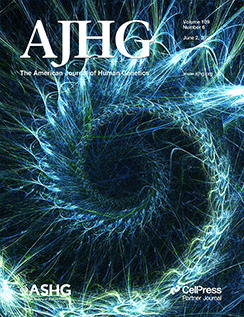Skeletal muscle eQTL meta-analysis implicates genes in the genetic architecture of muscular and cardiometabolic traits.
IF 8.1
1区 生物学
Q1 GENETICS & HEREDITY
引用次数: 0
Abstract
Identifying genetic variants that regulate gene expression can help uncover mechanisms underlying complex traits. We performed a meta-analysis of skeletal muscle expression quantitative trait locus (eQTL) using data from 1,002 individuals from two studies. A stepwise analysis identified 18,818 conditionally distinct signals for 12,283 genes, and 35% of these genes contained two or more signals. Colocalization of these eQTL signals with 26 muscular and cardiometabolic trait genome-wide association studies (GWASs) identified 2,252 GWAS-eQTL colocalizations that nominated 1,342 candidate genes. Notably, 22% of the GWAS-eQTL colocalizations involved non-primary eQTL signals. Additionally, 37% of the colocalized GWAS-eQTL signals corresponded to the closest protein-coding gene, while 44% were located >50 kb from the transcription start site of the nominated gene. To assess tissue specificity for a heterogeneous trait, we compared colocalizations with type 2 diabetes (T2D) signals across muscle, adipose, liver, and islet eQTLs; we identified 551 candidate genes for 309 T2D signals representing 36% of T2D signals tested and over 100 more than were detected with any one tissue alone. We then functionally validated the allelic regulatory effect of an eQTL variant for INHBB linked to T2D in both muscle and adipose tissue. Together, these results further demonstrate the value of skeletal muscle eQTLs in elucidating mechanisms underlying complex traits.骨骼肌eQTL荟萃分析暗示了肌肉和心脏代谢特征遗传结构中的基因。
识别调节基因表达的基因变异有助于揭示复杂性状的潜在机制。我们使用来自两项研究的1002个个体的数据对骨骼肌表达数量性状位点(eQTL)进行了荟萃分析。逐步分析发现12,283个基因中有18,818个条件不同的信号,其中35%的基因包含两个或两个以上的信号。这些eQTL信号共定位与26个肌肉和心脏代谢性状全基因组关联研究(GWASs)鉴定了2252个GWAS-eQTL共定位,提名了1342个候选基因。值得注意的是,22%的GWAS-eQTL共定位涉及非主eQTL信号。此外,37%的共定位GWAS-eQTL信号与最近的蛋白质编码基因相对应,44%的共定位GWAS-eQTL信号位于距离指定基因转录起始位点bbb50 kb处。为了评估异质性状的组织特异性,我们比较了共定位与2型糖尿病(T2D)信号在肌肉、脂肪、肝脏和胰岛eqtl中的分布;我们确定了309个T2D信号的551个候选基因,占测试T2D信号的36%,比单独检测任何一个组织多100多个候选基因。然后,我们从功能上验证了与肌肉和脂肪组织中T2D相关的INHBB的eQTL变异的等位基因调控作用。总之,这些结果进一步证明了骨骼肌eqtl在阐明复杂性状的机制方面的价值。
本文章由计算机程序翻译,如有差异,请以英文原文为准。
求助全文
约1分钟内获得全文
求助全文
来源期刊
CiteScore
14.70
自引率
4.10%
发文量
185
审稿时长
1 months
期刊介绍:
The American Journal of Human Genetics (AJHG) is a monthly journal published by Cell Press, chosen by The American Society of Human Genetics (ASHG) as its premier publication starting from January 2008. AJHG represents Cell Press's first society-owned journal, and both ASHG and Cell Press anticipate significant synergies between AJHG content and that of other Cell Press titles.

 求助内容:
求助内容: 应助结果提醒方式:
应助结果提醒方式:


